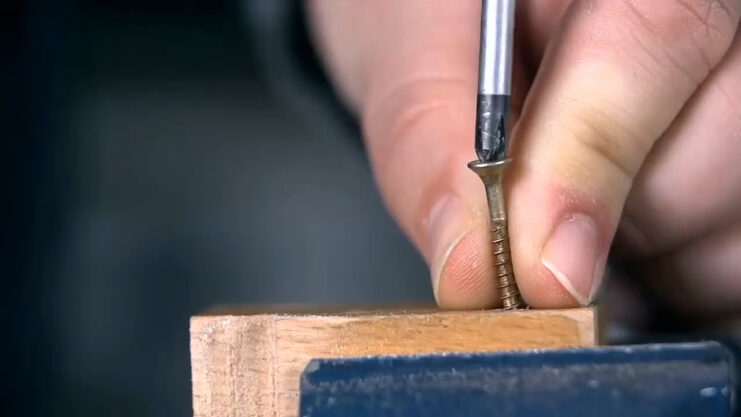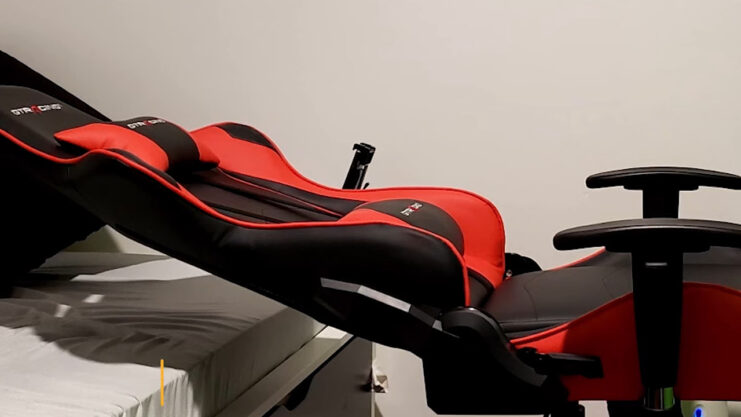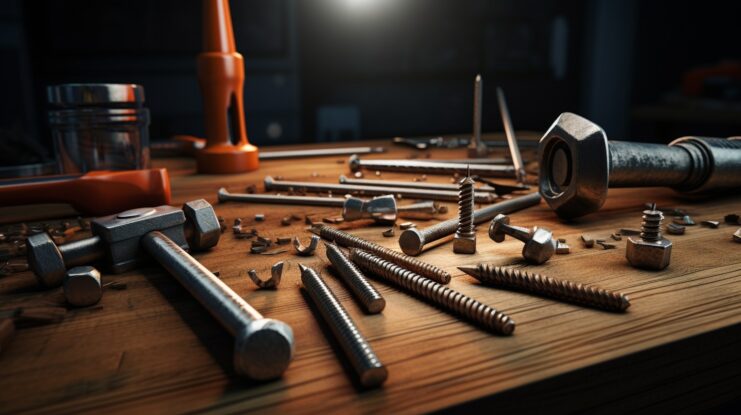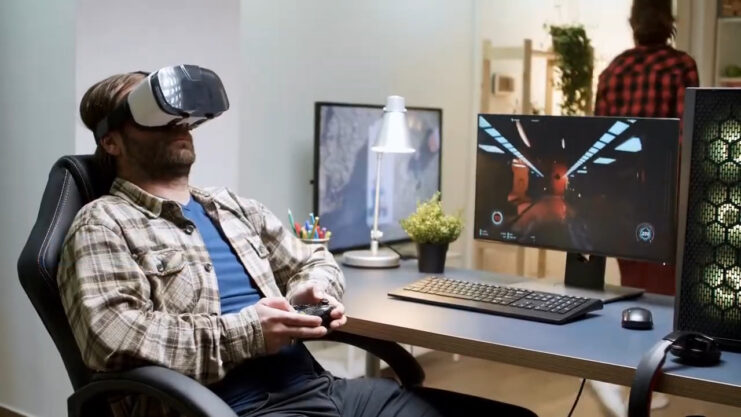As a dedicated gamer, I know that having a comfortable and sturdy gaming chair is essential for those long hours spent in front of a screen. Having a proper working chair for your gaming sessions is as much as important as having a clean gaming mouse pad.
Over time, even the best gaming chairs can begin to develop issues, one of the most common being wobbliness. This not only causes discomfort but can also negatively impact your gaming experience. Having dealt with wobbly gaming chairs myself, I’ve successfully managed to fix these issues using a variety of techniques.
Today, I want to provide you with step-by-step solutions to ensure it is stable again and ensure you can focus on what really matters – winning those games.
How to Fix a Wobbly Gaming Chair?
First, inspect the legs to identify any visible loose screws and bolts. If you find any, use a screwdriver or a hex key appropriate for the hex screws to tighten them, thus securing the bolts and screws. However, if it still wobbles after securing the loose screws and bolts, it’s time to move on to the next step.
Replacing Damaged Parts
Upon further inspection, you might discover some damaged parts. In that case, you’ll make a list of the replacement parts needed and find suitable matches for my model. Some common replacement parts are:
- Screws and bolts
- Leg braces
- Caster wheels
- Height adjustment lever
For wooden chairs with damaged or split screw holes, you may apply some wood glue in the damaged area and clamp it until dry, restoring the structural integrity of the hole. After getting the required replacement parts, you’ll carefully replace them and test the chair to ensure the wobble is fixed.

Adjusting Height
One possible reason my gaming chair might wobble is due to the uneven distribution of weight when it’s raised or lowered. To adjust the height of the chair and fix the wobble, you should:
- Sit on the chair and check if the weight distribution feels correct.
- Use the adjustment lever to find the height at which the wobble is minimized.
- Lock the chair at that height.
A proper height adjustment should reduce or completely eliminate the wobble, allowing me to enjoy my gaming sessions comfortably. By following these steps, you can fix the wobbly gaming chair and ensure it’s stable and secure.
Identifying the Problem
Indentifying the problem is the first order of business, as you can presume.
Checking the Chair
You need to thoroughly examine it to pinpoint the cause of its wobbliness. To do this, start by gently shaking to identify any movement in its structure. It’s essential to look for any unusual motions or sounds while performing this action.
Spot the Loose Components
Next, I will make a list of all the components of my chair that show any signs of being loose. Here are some common areas that can cause wobbliness:
- Base: The chair’s base provides stability. Check if any screws or bolts need to be tightened, or if any component is misaligned.
- Wheels/Casters: The wheels should rotate smoothly without unwanted movement. Ensure that they are properly attached to the base.
- Gas Lift: This helps with height adjustment, and a loose gas lift might contribute to instability. Inspect if it’s securely connected to the base, seat, and overall mechanism.
Inspect for Broken or Damaged Parts

It’s crucial to identify any broken or damaged components of my gaming chair. A damaged part can compromise the structural integrity, leading to wobbliness. I will inspect the chair thoroughly, paying attention to:
- Welds and Joints: Look for any cracked or broken welds, as well as loose or separated joints.
- Metal Frame: Examine the frame for cracks, bends, or any other signs of damage.
- Upholstery and Padding: Check if there’s any excessive wear or damage to the upholstery and padding, which can affect even distribution of weight and balance.
Review the Overall Chair Design
If you find any missing components or if something appears to be installed incorrectly, you should consult the chair’s assembly instructions or the manufacturer’s website for guidance. Some specific aspects to consider include:
- Armrests: Ensure they are securely attached and correctly aligned to the seat.
- Backrest: Double-check if it is properly connected to the seat and functioning as intended.
- Chair Mechanism: Make sure that the chair tilts and adjusts smoothly and without any issues.
Tools Required for Fixes
Before you start fixing a wobbly gaming chair, it’s crucial that I gather all the necessary tools. This ensures a smooth and efficient process. Below is a list of the most commonly needed tools to perform this task:
| Tool | Purpose |
|---|---|
| Screws | Essential for securing parts of the chair together. |
| Screwdriver | A must-have for tightening or loosening screws. |
| Bolts | Similar to screws, used to fasten components together. |
| Pliers | Handy for gripping and manipulating small objects. |
| Wrench | Useful for tightening or loosening fasteners like nuts and bolts. |
| Hammer | Useful for driving tight-fitting parts into place. |
| Clamp | Provides extra support and stability during repairs. |
| Flat-head Screwdriver | Works for both tightening screws and prying needs. |
| Allen Wrench | Key tool for operating Allen screws, commonly found in gaming chairs. |
This list should cover most of the tools you’ll need during my repair.
Depending on the specific chair, there might be additional tools necessary which I will make sure to gather.
The Use of Each Tool

Now that you’ve gathered the tools, let me briefly explain the purpose of each one to ensure a proper understanding of their role in fixing a wobbly gaming chair.
- Screws and bolts: These provide stability and strength to the different parts of the chair. I need to check them regularly and keep them tightened to avoid any wobbliness.
- Screwdriver, flat-head screwdriver, and Allen wrench: These tools help me tighten or loosen screws and bolts, ensuring that all parts are properly fastened together.
- Pliers: Sometimes I may need to grip or bend small components that are difficult to handle with my fingers. Pliers are perfect for such tasks.
- Wrench: A wrench, especially an adjustable one, makes it easy for me to tighten or loosen nuts and bolts that secure the chair’s components together.
- Hammer: Carefully using a hammer can help me drive tight-fitting parts in place or fix any bent metal that may be causing the chair to wobble.
- Clamp: If I need to hold parts securely in place while working, a clamp will help me maintain stability and ensure a proper fix.
With my tools gathered, and an understanding of how to use them, I’m now well-prepared to tackle any issues that I come across.
Enhancing Comfort and Durability
To enhance the comfort and durability, you need to maintain a proper sitting posture. A good sitting posture ensures that the backrest, lumbar support, and cushion align well with my body, providing the necessary support.
I prefer to sit up straight with my feet flat on the floor, and knees bent at a 90-degree angle. This avoids putting unnecessary strain on the chair while improving my gaming experience.
Regular Chair Inspection
I regularly inspect my gaming chair to identify any loose fittings, wobbly parts, or signs of wear and tear.
Checking the chair thoroughly helps me prevent minor issues from escalating into a significant problem that compromises the chair’s comfort and durability.
Tighten any loose screws and bolts, ensuring that the adjustable armrests and back support remain secure.
Choosing Quality Gaming Chairs

I understand the importance of selecting a high-quality gaming chair made of premium materials for enhanced comfort and durability. When shopping for a chair, I look for the following features:
- Cushioning: A comfortable seat cushion and headrest made of dense, high-quality foam can significantly improve my gaming experience.
- Backrest and Lumbar Support: A well-designed backrest provides adequate back support, while lumbar support helps to maintain the natural curve of my lower spine.
- Adjustable Armrests: Armrests that can be adjusted in height and angle allow me to find the perfect position for my arms while gaming.
Equally important for your back and wrist health is having the right palm grip mouse to go with your setup, so you can withstand those long gaming sessions without feeling like you got hit with a truck after two hours of gaming.
FAQs
Could the armrests be causing my chair to wobble?
Loose armrests can contribute to wobbliness. Tighten their connecting bolts or screws.
What maintenance can prevent future wobbling?
Regular tightening of screws and bolts, and periodic inspection of parts can prevent wobbling.
Are there any quick fixes for a slightly wobbly chair?
Temporary fixes include tightening all visible screws and placing the chair on a more even surface.
How often should I check my gaming chair for looseness or wobble?
It’s a good practice to check it every 3-6 months, depending on usage.
Can over-tightening screws damage the chair?
Yes, over-tightening can strip the threads or crack the frame. Tighten just until firm.
The Bottom Line
Fixing a wobbly gaming chair is often a straightforward task that can significantly improve your gaming experience. Regular maintenance and these simple fixes can extend the life of your gaming chair, ensuring comfort and stability during those intense gaming sessions.
Remember, a stable chair not only enhances your gaming experience but also supports good posture and ergonomics, which are vital for long-term health and comfort.

